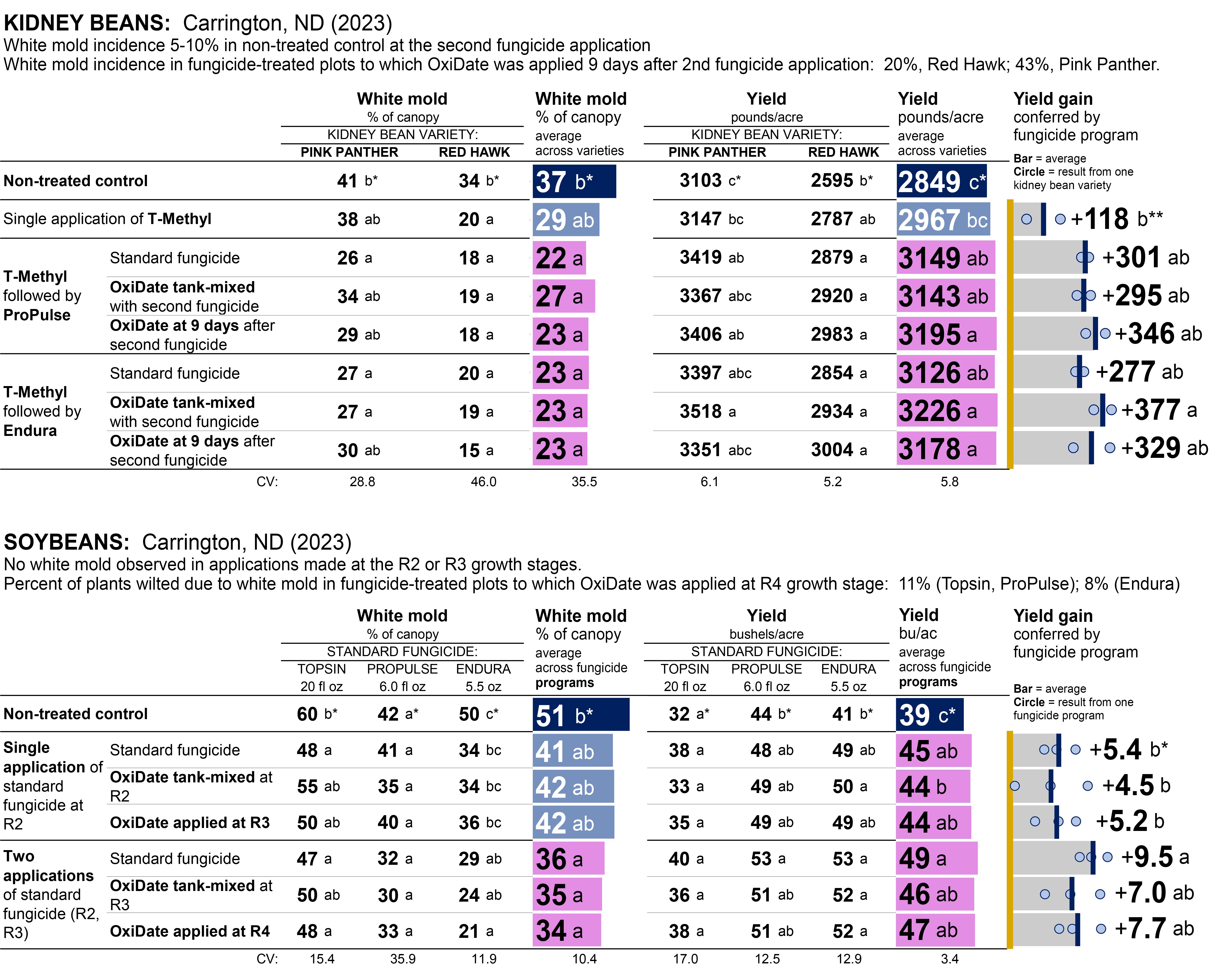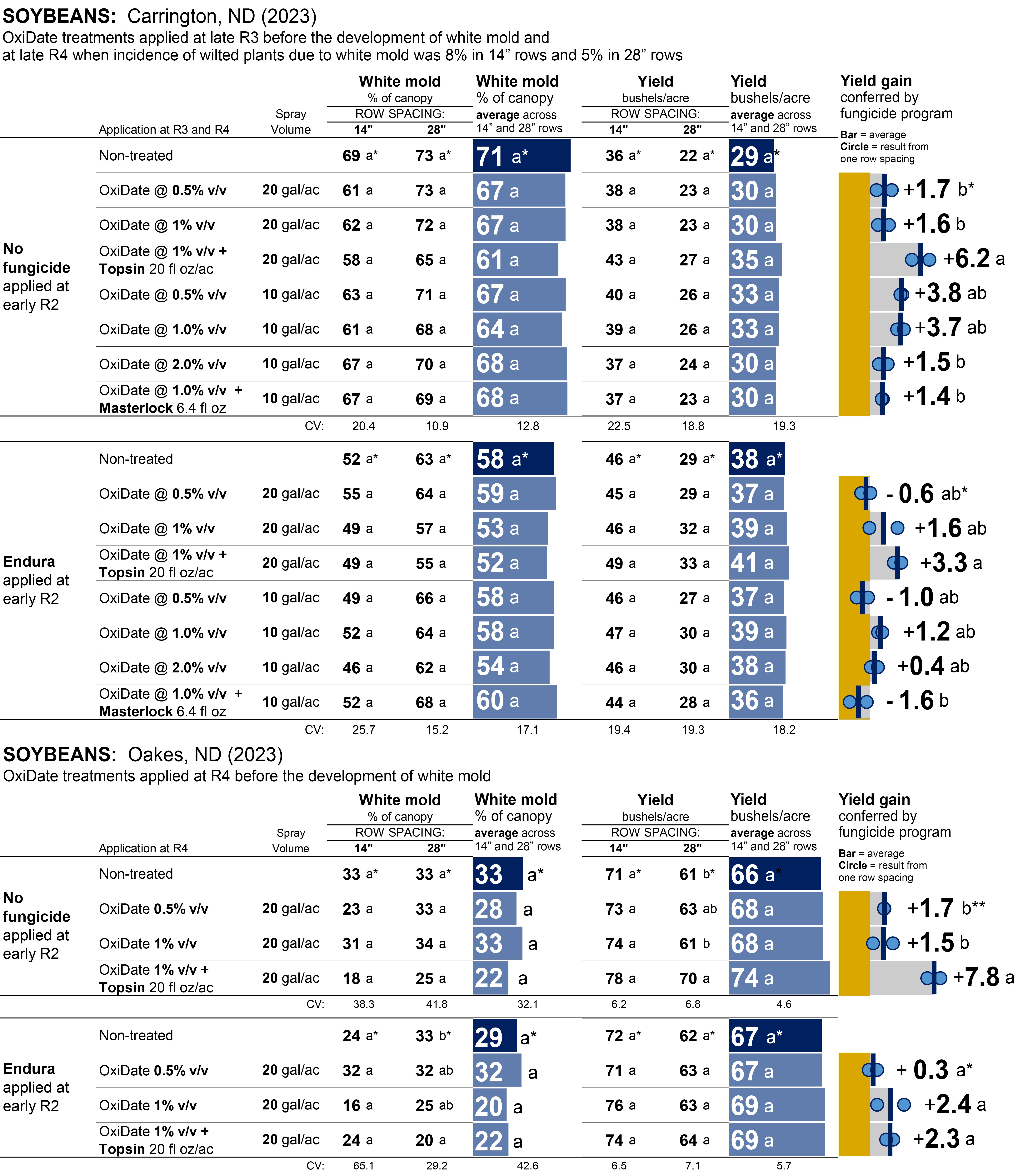The use of peroxide-based fungicides has been adopted by some producers in our region as a tool for inhibiting the development of white mold and this study was designed to provide rigorous data to growers, agronomists, and crop advisors who have inquired about the efficacy and profitability of this management tool.
Applications of the peroxide-based fungicides OxiDate 5.0 (hydrogen peroxide, 27%; peroxyacetic acid, 5%) and SaniDate 12.0 (hydrogen peroxide 18.5%, peroxyacetic acid 12.0%) were made to irrigated soybeans in Carrington and Oakes, ND. The efficacy of OxiDate 5.0 was tested at 1.0% v/v in 15 gal/a tank-mixed with traditional fungicides at standard fungicide application timing and as a stand-alone application after white mold disease development to dry beans and soybeans that received the two-application sequence of traditional fungicides. The impact of application rate and spray volume on the efficacy of OxiDate 5.0 was tested with applications at the R3 and/or R4 growth stage with a tractor-mounted sprayer equipped with a pulse-width modulation system. Pulse width was manually calibrated on the basis of the measured spray output to maintain a constant driving speed across treatments differing in spray volume. Applications of OxiDate 5.0 were made with flat-fan nozzles and medium or coarse droplets, with spray droplet size calibrated relative to canopy closure. Applications of SaniDate 12.0 were conducted via chemigation, with SaniDate applied at 0.02% v/v in 0.19 inch of irrigation at the early R3 and full R4 growth stages. To facilitate proper randomization of treatments, chemigation was delivered via rotating micro-sprinklers established in an offset, overlapping pattern. To ensure rigorous results, all studies were conducted with 6 to 12 experimental replicates.
Applications of OxiDate 5.0 and SaniDate 12.0 were often associated with moderate improvements in white mold management and soybean yield, but variability in the response to the peroxide-based fungicides was high and no statistically significant responses were observed. The impact of OxiDate 5.0 on end-of-season white mold severity and soybean yield were similar irrespective of application rate and spray volume. Applications of the traditional fungicides Endura, Topsin and ProPulse conferred stronger, more consistent improvements in white mold that were often statistically significant (P < 0.05). The results suggest that OxiDate 5.0 and Sanidate 12.0 may have limited effectiveness against white mold in kidney beans and soybeans.
Harvest of soybeans in the peroxide-based products evaluation.
Figure 1. Efficacy of Oxidate 5.0 applied at 1.0% v/v in 15 gal/a applied as a tank-mix with traditional fungicides at standard fungicide application timing or applied as a stand-alone application to kidney beans or soybeans that received two applications of a standard fungicide. In dry beans, testing was conducted with T-methyl @ 40 fl oz/ac or T-methyl followed by Endura @ 8 oz/ac. In soybeans, testing was conducted by a single or two sequential applications of T-methyl @ 20 fl oz/ac, ProPulse @ 6 fl oz/ac, and Endura @ 5.5 oz/ac. Within-column means followed by different letters are significantly different (P < 0.05; Tukey multiple comparison procedure).
Figure 2. Impact of application rate, spray volume, and tank-mix partners on efficacy of Oxidate 5.0. Applications were made with a tractor-mounted sprayer at the R3 and/or R4 growth stages. Within-column means followed by different letters are significantly different (P < 0.05; Tukey multiple comparison procedure).
Figure 4. Efficacy of SaniDate 12.0 (0.2% v/v) applied via chemigation in 0.19 inch of water at the early R3 and full R4 growth stages, Carrington, ND (2023). Within-column means followed by different letters are significantly different (P < 0.05; Tukey multiple comparison procedure).
Partial support for this research was provided by the North Dakota Soybean Council.


